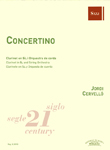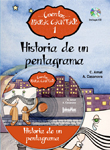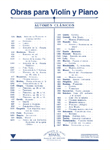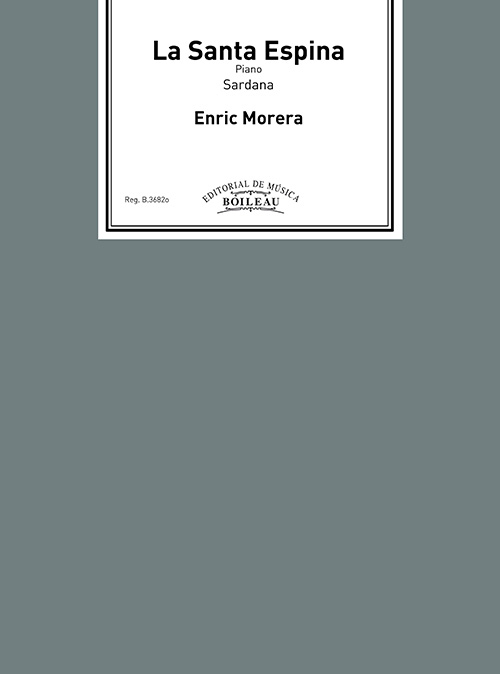La Santa Espina - Sardana
Materiales de orquesta sinfónica en alquiler
Orquesta sinfónica con Tenora y/o Voz ad libitum
MORERA, EnricReg.: B.3682o
- Review: SERRACANT, Josep Maria
- Ensemble: Symphonic orchestra: With voice/choir.
Choir: With accompaniment; Mixt. - Genres: Classical / contemporary: Choir; Symphonic.
Folk music / traditional: Sardanas.
- Lyric author: GUIMERÀ, Àngel
- Language: Catalán
- Product format: Partitura + particellas
- Difficulty level: Advanced-superior
- Period: 1st half S. XX
- Publishing house: Editorial Boileau
- Collection: Siglo XXI
- No. of pages: 336
- Measure: 29,70 x 21,00 cm
- Lenght: 4'00''
- ISMN: 979-0-3503-1013-3
- Available in digital: No
- Available for rent: Yes
Unison choir or Solo voice (ad lib.)
3[1.2.pic] 3[1.2.Eh] 3[1.2.bcl] 3[1.2.cbn] — 4 3 3 1 — Tenora (ad lib.) — tmp+2 — hp —str
perc: sd, sus cym, tri, tbrí
Strings: 7,6,5,4,3
Introduction:
La Santa Espina, as described in the libretto by author Àngel Guimerà, is a Rondalla en tres actes i sis quadres (Rondalla in 3 acts and 6 scenes), with music by Enric Morera. This work forms part of the theatrical movement known as the Teatre Líric Català, which musicologist Xosé Aviñoa states was active between 1894 and 1908. Important composers such as Morera, Granados and Pahissa, along with authors such as Guimerà, Rusiñol and Pitarra, among others, joined together to produce theatrical works with music, as an alternative to Italian opera, the overwhelming presence of Wagner’s operas and Spanish zarzuela. The attempt was to create a true Catalan musical theater.
One of the most important productions of the Teatre Líric Català was La Santa Espina. One of the twenty musical pieces included in La Santa Espina is the famous sardana of the same name, which is in the third act. This sardana became an emblematic symbol of Catalanism, especially after it was prohibited by the Gobernador Civil de Barcelona, General Losada, in 1924.
It is interesting to read the text of the brochure which was distributed at the time:
It has come to the attention of this Civil Governament, in a form which does not leave any doubt, that certain individuals have converted the sardana La Santa Espina, a work with presents hateful ideals and criminal aspirations, into a sort of patriotic hymn, listening to it and singing it with the reverence appropriate to a national anthem. Accordingly, the Civil Government prohits that sardana from being played or sung on public streets, in concert halls, in private associations, and during excursions or meetings in the country. All are hereby advised that those who do not observe this order will be punished to the fullest extent of the law.
La Santa Espina was premiered at the Teatro Principal, Barcelona on January 19, 1907. It was later performed again in December of the same year. In all there were more than 200 performances. It was produced by Espectáculos y Audiciones Graner under the theatrical direction of Modest Urgell. The success of the work surpassed all expectation, especially since it was not common at that time for any musical theater piece to be presented for more than two or three weeks. The popularity of La Santa Espina was such that it was performed many more times than anyone imagined possible.
The plot is a fantasy which incorporates all the elements of this genre during that: witches, warlocks, mermaids, kingdoms of distant lands, incantations, etc. All of these elements were transformed into a work of Catalan nationalism at a very delicate and tense moment for Catalan society and politics. The music of Morera is entirely tonal and perfectly in character with the libretto.
As commented above, the piece which later became the popular sardana is found in the third act of La Santa Espina. It occurs at the moment when the Catalan captives are introduced. Following a poetic and evocative introduction, the Catalan women begin to sing the famous verses, in the style of a dance, "Som i serem gent catalana" (We are and always will be Catalans). The sardana inself begins with the llargs* (long steps) which coincides with a modulation to the minor mode. This opening music is different from the curt* (short steps) of the sardana since both the meter and melodies are different, alternating measures of ternary and binary beats.
Morera arranged this sardana the same year of the premiere, 1907, converting it into an independent work. The first version with a text is the recording by Emili Vendrell in 1918. In this recording there is only text in the section of the llargs, which fits perfectly with the music. Later other arrangements were made in which the text begins in the curts.
* Even the earliest sardanas were in binary form in which, following a repeat, divides the work into two parts: curts (short steps) y llargs (long steps), names which are obviously derived from the steps of the dance. The short steps are danced with the arms down and the long steps are danced with the arms raised.
Synopsis of the Plot:
Harvest time requires the efforts and attention of everyone. Harvesting, carting, shredding, storing. . . everything has to be done at once. Maria, the oldest (pubilla**), is celebrating the evening before her saint’s day. She takes a basket and goes out to collect wild flowers to make an offering to the statue of the Virgin that she has in her room. She takes longer than she should have and her parents begin to worry. Her father is afraid that she is with Gueridó, a not very smart young man who works as a horseman shepherd on the farm.
Finally Maria arrives at the forest to meet Gueridó who helps her make a bouquet of flowers. María does not have string to tie the bouquet together and she decides to use her gold chain with her locket, which contains a relic of La Santa Espina (The Holy Thorn), which Jesus wore on the cross. Gueridó tries to kiss her. Surprised by his daring, she shouts for help. Because of this daring gesture Gueridó is fired from the farm. Before he leaves he decides that he wants something to remember his girl and takes the bouquet.
With the bouquet as a consolation, he walks throughout the night without stopping until he arrives at a dark and deep valley. That night witches and warlocks are meeting to choose the person that they will make the happiest person in the world. When they see Gueridó they choose him. In spite of his objections and excuses, they decide to make him a King. However, they make one condition: if he does not kiss his beloved for one year he will be King forever. However, if he does kiss her he will loose everything. After all is said and done they set out to sea in a huge shoe and take him to an island where a true Prince is just about to be crowned.
Prince Arnold has retreated to a castle since on the day of his birth astrologists predicted that he would be turned into a plant when he found true love. Being tired of waiting, he goes, along his body guard, to visit the beautiful Rosa Vera, a mermaid with whom he has fallen in love. As they leave the two men come upon the witches. By magic the Prince and his court are converted into palm trees. The witches then remove all of Gueridó’s clothing, discarding it along with the bouquet of flowers and the chain and locket. After he is dressed in the Prince’s clothing, representatives of Abracandària, the country of Prince Arnold, arrive to tell him that his father, the King, has died. They take Gueridó with them to crown him are the new King without realizing that he is impersonating the Prince.
The mermaid Rosa Vera has seen everything. Being aware of the magic spell, she decides to do everything possible in order to break the spell. Dressed as a sailor, she finds the bouquet of flowers with the chain and locket and returns them to Gueridó. He, in turn, appoints her as a Page in his court. Thus, Rosa Vera, who is now called Dardet, becomes the confidant of the King. She takes advantage of her power in the court to have boats of young women come to the palace so that the King might fall in love. But, time passes and nothing changes.
One year has almost passed and everyone is somewhat pessimistic. A boat filled with Catalan maidens arrives at Abracandària. The Captain who kidnapped the girls tells where they came from. As he listens to the Captain, the King remembers his country, his parents, María, the cows and the mountains of Montserrat, the beaches, etc. With tears in his eyes, he thinks he is dreaming. At this moment the Catalan maidens begin to dance a sardana while singing “Som i serem gent catalana, tant si es vol com si no es vol...” (We are and will always be Catalans, whether you like it or not…) while Gueridó weeps with emotion while his people attempt to calm him..
The false King suddenly discovers that Maria is one of the maidens. Without her realizing it, he quickly orders that she be prepared to marry him. However, not believing that he is the horseman that she has dreamed of since he left the farm, she is not convinced. But, when he presents her with the bouquet of flowers and the chain and locket she recognizes him as her beloved Gueridó. Rosa Vera, dressed as a page, tells of the spell cast upon Maria and she kisses Gueridó as the clock strikes twelve, breaking the spell on him, Arnold and his men. Rosa Vera recovers be beloved Prince while Maria and Gueridó return to their country, seeing in the distance the mountains of Montserrat, one of the most emblematic symbols of Catalunya.
**Pubilla, (Inheritor, in Catalunya the first born inherits the family fortune).









